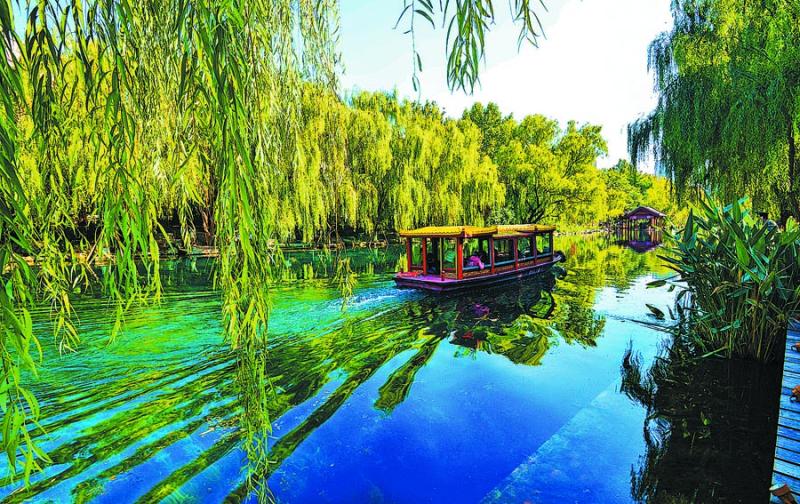Springing into action
By: Pan Zhongming and Zhao Ruixue

Springing into action

The Black Tiger Spring is one of the biggest attractions in Jinan, Shandong province. It gets its name from the roaring sound of water that gushes out of tiger head-shaped stones. [Photo provided to China Daily]
Jinan protects and utilizes its water supply as gushing resource attracts admirers, Pan Zhongming and Zhao Ruixue report.
Thanks to abundant rainfall and the unremitting endeavor of the local government, Jinan, the provincial capital of Shandong that is dubbed the "city of springs", has seen a year of remarkable achievement.
The Baotu Spring, a renowned scenic spot in the city's Lixia district, saw its water table exceed 30 meters on Oct 11 to reach the highest level for that time of year since it started gushing again in 2003, according to the city's water affairs bureau.
Since early this year, the spring's water table has been on the rise, the bureau says.
Springs have long been cherished by Jinan residents. Over a century ago, author Liu E described Jinan in his novel, The Travels of Lao Can, as a place where "springs bubble in every yard, and weeping willows surround every household".
There are 1,209 artesian springs in Jinan, according to a list published in September last year.
The artesian wells bubble from the hydraulic pressure caused by the sharp geographical decline of the location on which the city is built, with Taishan Mountain to its south and the lower part of the Yellow River to its north.

In cold winters, the mist rises and floats over the springs, adding a mystic touch to the city. [Photo provided to China Daily]
The southern hilly area, which also collects and generates the spring water, is higher than the river plain to the north. The groundwater flows downward and gushes out at the foot of the hills.
Within the old city area alone, dozens of springs, including Black Tiger, Fairy, Agate and Lute, sit along a moat that encompasses the city.
In some springs, bubbles are seen rising from the bedrock. The spring water is so clear that tourists can see the bottom of the springs.
The Black Tiger Spring originates from a 3-meter-deep, 1.7-meter-wide natural cave. Its name comes from the roaring sound it makes when water gushes out of tiger head-shaped stones.
The water flows into the moat which runs into Daming Lake. The moat is the focal area where the city's elderly and the young like to gather.
In addition to taking a leisurely walk along the moat, tourists can opt for a boat. The trip along the moat stops at five scenic spots — Black Tiger Spring, Square of the Spring City, Baotu Spring, Five Dragons' Pool and Daming Lake, the major spring views in Jinan.

Jinan has a lot to offer to visitors throughout the year. Taking a boat ride along the moat is popular in summer. [Photo provided to China Daily]
Around 50 kilometers to the east of the old city area, a park of Baimai Springs, which translates to "100 springs", located in Jinan's Zhangqiu district, is a popular place on weekends.
In the park, spring water flows over stone steps.
Springs have long been integrated into residents' lives. Authorities have regarded the springs as the lifeblood and soul of the city — the protection of the springs was a major priority when the subway was built and older communities renovated.
In recent years, the local government has boosted the springs with water replenishment and improved the ecological environment in the supply area.
Since 2019, 315 private wells have been closed, which has reduced the use of underground water by 12 million cubic meters, authorities say.
Ecological systems have been substantially improved at water conservation areas around several rivers to ensure abundant underground water supply for the springs.

In cold winters, the mist rises and floats over the springs, adding a mystic touch to the city. [Photo provided to China Daily]
The springs in Jinan not only provide stunning views but also drinking water.
Close to the Black Tiger Spring, there is a spot where people can collect water from pipes. They use the spring water to make tea and cook meals.
"I come here to get water every day. I use the spring water to make tea and porridge," says a Jinan native who gave his name as Li.
"When I was young, my parents put watermelons in the spring water to keep the fruit fresh and cool," he says, adding that the springs in Jinan are a way of life.

Springs are an important part of local life in Jinan. People enjoy outdoor activities around the springs and collect spring water to cook meals and make tea. [PHOTO BY ZHAO RUIXUE/CHINA DAILY]
Fountains are set in the old city area where tourists can get supplies.
Freddy Fredes, from Chile, who studied in Shandong Normal University, is impressed.
"Walking around the parks and springs, you can see the trees, the springs and the plants. You feel so relaxed and you feel so good with yourself," he says.
"Many people think that the protection of the environment and the development of the city are opposite things, but in Jinan, I realized that these two things can be carried out together at the same time."

Springs are an important part of local life in Jinan. People enjoy outdoor activities around the springs and collect spring water to cook meals and make tea. [PHOTO BY ZHAO RUIXUE/CHINA DAILY]
.

Springs are an important part of local life in Jinan. People enjoy outdoor activities around the springs and collect spring water to cook meals and make tea. [PHOTO BY ZHAO RUIXUE/CHINA DAILY]




Comments are subject to the Discovery Group RED BOX RULES which can be accessed by clicking on this link -> or by clicking on the Discovery Group avatar at the top right of the article page above, either of which will take you to the Discovery Group home page.
Political comments are off topic and will be deleted.
The bottom photo makes me think back to summer days at our lakeside home. Even though the water that we pumped into the chalet was government tested annually to be potable, and we used a "stone" filter in our kitchen sink, we would get in the boat with a couple 5 gallon jugs and fill them at a spring across the lake that was very much like what you see in that bottom photo.
Great photos and story. I especially like that they have closed so many private wells to protect the springs.
Here in central Florida, we are blessed with many natural springs and two of our rivers are totally spring-fed, the Silver River and the Rainbow River.